- Fractional CMOs provide part-time executive marketing leadership, aligning strategy, data, and creativity for scalable e-commerce growth.
- Fractional CMOs deliver cost-efficient, flexible alternatives to full-time CMOs, driving ROI through strategic oversight, data governance, and martech integration.
- Fractional CMO leadership unifies agencies, teams, and technology to transform marketing from reactive execution into a proactive growth engine.
The fractional CMO for eCommerce is a modern marketing leadership model designed for rapid change and competition. By combining strategic vision, operational precision, and cross-functional collaboration, fractional CMOs help e-commerce brands scale efficiently and turn marketing into a proactive growth engine. Creative partners complement this approach by providing the expertise to bring strategy to life, creating a framework where strategy meets creativity.
Adopting fractional CMO services allows organizations to access top-tier leadership, reduce operational risk, and maintain momentum in every market cycle. This model is more than a cost-saving measure; it’s a strategic evolution shaping the future of competitive advantage in e-commerce.
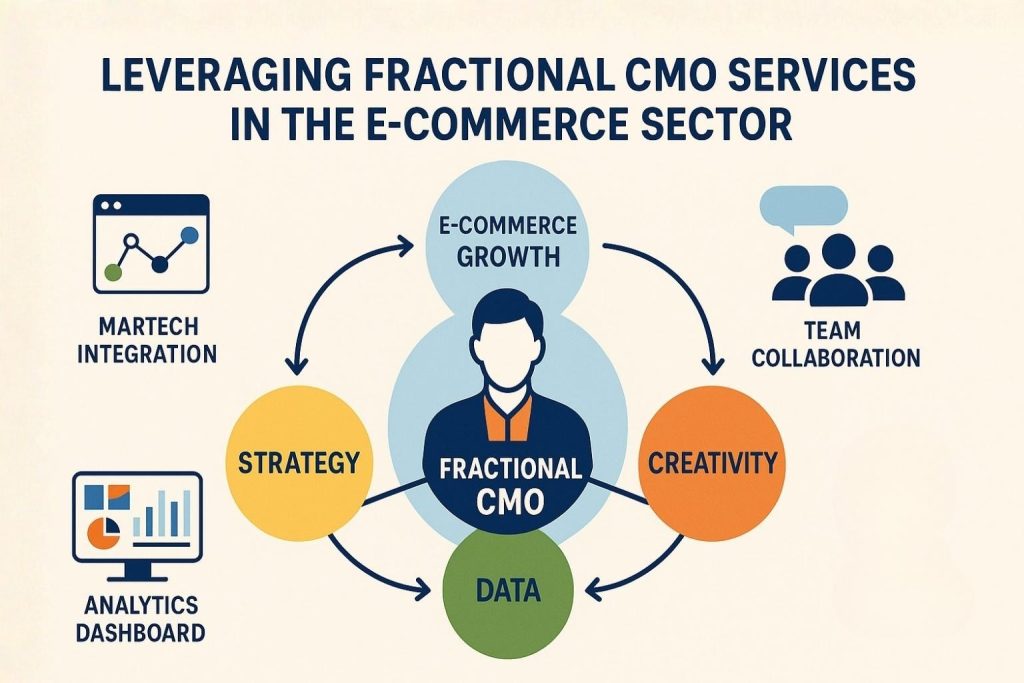
The Strategic Imperative: Marketing Leadership in Modern E-Commerce
The Shift in E-Commerce Dynamics
The e-commerce sector is now one of the most competitive business landscapes. Customer acquisition costs are rising, organic reach is declining, and differentiation depends on data-driven personalization and innovation. Brands operate across multiple platforms, from Amazon and Shopify to social commerce, each requiring unique optimization.
According to FedEx’s Global Small Business Hub, worldwide retail e-commerce sales are projected to surpass US $8 trillion by 2026. This growth underscores the importance of expert marketing leadership, particularly a fractional CMO for e-commerce, to ensure sustainable growth. Without centralized leadership, marketing often becomes reactive, campaigns fragmented, and budgets underutilized, making strategic oversight more crucial than ever.
Where Agencies and In-House Teams Fall Short
Many brands depend on e-commerce marketing agencies for executional expertise. Agencies bring valuable creative and technical skills, but they often lack access to the company’s broader strategic context. Without executive oversight, agency efforts can drift from profitability metrics or long-term brand positioning, a challenge often solved through strategic collaboration between leadership and agency partners.
In-house teams, on the other hand, may lack the external perspective or agility to keep pace with emerging technologies such as generative AI, e-commerce, or automated media optimization. The leadership gap becomes apparent when growth stagnates despite increased marketing spend.
A fractional CMO for eCommerce fills this gap by aligning both internal and external teams under unified strategic leadership, ensuring every marketing activity directly contributes to the company’s commercial objectives.
Understanding the Fractional CMO Model
Definition and Structure
A fractional CMO is a senior marketing executive who works with organizations on a part-time, contract, or project basis to provide high-level strategic leadership. In the e-commerce context, this model allows businesses to access top-tier marketing expertise without hiring a full-time C-suite executive. Engagement structures vary, including:
- Retainer-based models, where the fractional CMO provides ongoing leadership across multiple business units.
- Interim engagements, designed to stabilize marketing operations during transitions or scaling periods.
- Project-based assignments, focused on specific initiatives such as new product launches or international expansions.
Fractional vs. Full-Time CMO vs. Consultant
While a full-time CMO leads internal teams exclusively, a fractional CMO provides similar expertise with greater flexibility and cost efficiency, a distinction that becomes clearer when exploring how each model shapes long-term marketing leadership. While an e-commerce consultant provides valuable advisory support, the fractional CMO integrates deeply within the organization, driving strategic execution and measurable business outcomes.
Compared with an e-commerce consultant, a fractional CMO integrates more deeply into business operations, taking ownership of KPIs and strategic direction rather than offering only advisory input.
The eCommerce fractional CMO often functions as both strategist and operator, defining growth roadmaps, managing performance indicators, and ensuring tactical alignment across marketing, technology, and sales. The ecommerce fractional leadership model provides agility and precision, offering brands the flexibility to access senior marketing expertise exactly when and where they need it.
Economic and Operational Advantages
The advantages of adopting fractional CMO services include:
- Cost efficiency: Access to high-level leadership without full-time executive overhead.
- Speed to impact: Rapid onboarding and execution due to prior cross-industry experience.
- Scalability: Engagements can expand or contract based on growth phase or budget cycles.
- Strategic agility: Ability to pivot marketing structures in response to market shifts.
This approach transforms marketing leadership from a fixed cost into a flexible strategic asset.
The Economics of Hiring a Fractional CMO for E-Commerce
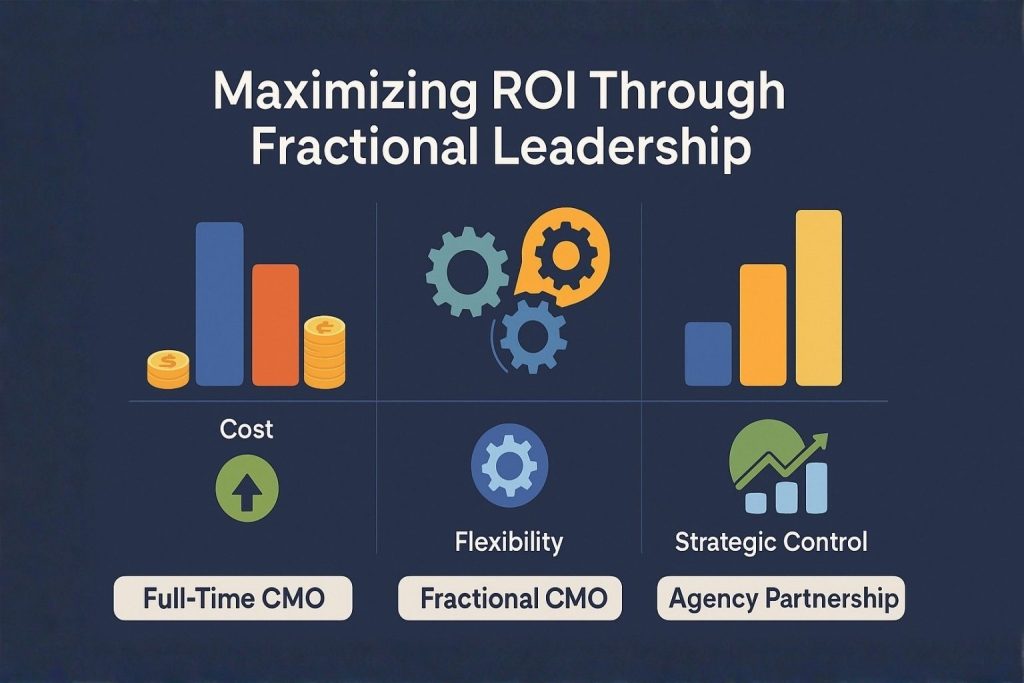
Strategic Cost Efficiency and Value Creation
E-commerce brands often face a clear dilemma: they need senior marketing leadership but can’t justify the cost of a full-time CMO. A fractional CMO for eCommerce solves this by offering top-tier expertise on a flexible, high-impact basis.
Key advantages include:
- Pay only for what you need: Access elite leadership for select hours or specific projects.
- Redirect capital efficiently: Invest more in performance channels, data systems, and product innovation instead of executive overhead.
- Faster results: Fractional CMOs bring cross-industry experience, accelerating the impact of your marketing programs.
Cost comparison:
- Full-time CMO: $250,000–$400,000 annually (excluding stock and benefits)
- Fractional CMO: $80,000–$150,000 annually (flexible retainer model)
For small and mid-sized e-commerce companies, these savings often free up hundreds of thousands of dollars for scaling campaigns, improving analytics, or expanding creative testing.
Data from The CMO Survey (2025) shows that marketing leaders expect an 8.9 % increase in total marketing budgets and an 11.9 % rise in digital marketing investment by 2026.
This expanding spend underscores why many brands adopt fractional leadership models to maximize strategic control without inflating fixed costs.
Comparative Economics
| Role Type | Typical Annual Cost | Engagement Structure | Strategic Control | Scalability |
| Full-Time CMO | $250K–$400K | Fixed Salary | High | Low |
| Fractional CMO | $80K–$150K | Flexible Retainer / Project-Based | High | High |
| Agency Partnership | $120K–$300K | Monthly Retainer | Medium | Medium |
Fractional CMOs combine the analytical depth of a full-time executive with the elasticity of a consultancy model. They can be deployed to stabilize underperforming channels, reframe customer acquisition costs (CAC), or architect a complete go-to-market strategy.
Return on Leadership Investment
The ROI horizon for fractional CMO services is typically shorter than that of permanent hires. Within the first 90–120 days, brands often realize measurable impact through:
- Channel Efficiency Optimization: Reallocating budgets to high-ROAS platforms and pruning underperforming campaigns.
- Revenue Acceleration: Redesigning paid acquisition strategies to increase conversion rates and AOV.
- Team Productivity Gains: Implementing streamlined operational frameworks that elevate in-house execution.
A well-managed engagement can produce a compounding effect on EBITDA margin improvement, brand equity, and marketing team maturity, three core metrics that investors closely monitor in e-commerce valuation models.
Technology Stack Leadership and Martech Integration
The Central Role of Martech in E-Commerce Performance
Modern e-commerce operations thrive on technology orchestration. Between CRMs, analytics tools, advertising platforms, and personalization engines, most businesses rely on a fragmented ecosystem of 20 to 40 technologies. Without strategic oversight, this stack becomes an operational liability rather than a performance enabler.
A fractional director of e-commerce strategy plays a central role in rationalizing this complexity. They audit existing tools, identify redundancies, and design a roadmap for future integrations, ensuring every component of the marketing technology stack contributes directly to growth and profitability.
Core Martech Domains Managed by Fractional CMOs
Fractional CMOs lead technical integration across multiple categories:
- CRM & Lifecycle Platforms: HubSpot, Klaviyo, Iterable, or Salesforce Marketing Cloud for automation and retention.
- Data & Attribution Systems: GA4, Triple Whale, and Northbeam for unified visibility across channels.
- Content & Experience Platforms: Shopify Plus, Magento, and headless CMS structures for flexibility and performance.
- AI & Personalization Tools: Dynamic creative optimization engines, product recommendation algorithms, and automated ad copy generation driven by generative AI e-commerce technologies.
Strategic Integration Blueprint
The value of Martech is not in the tools themselves, but in the connectivity between them. A fractional CMO ensures:
- Clean Data Flow: Seamless synchronization across CRM, CMS, and advertising APIs.
- Governance: Data compliance with GDPR and CCPA to mitigate regulatory risks.
- Scalability: Technology decisions that support future channel and regional expansion.
- Cost Efficiency: Elimination of overlapping or underutilized software subscriptions.
In short, the fractional CMO transforms Martech from a cost center into a growth multiplier, positioning technology as a strategic backbone rather than a tactical afterthought.
Data Governance and Attribution Modeling in E-Commerce
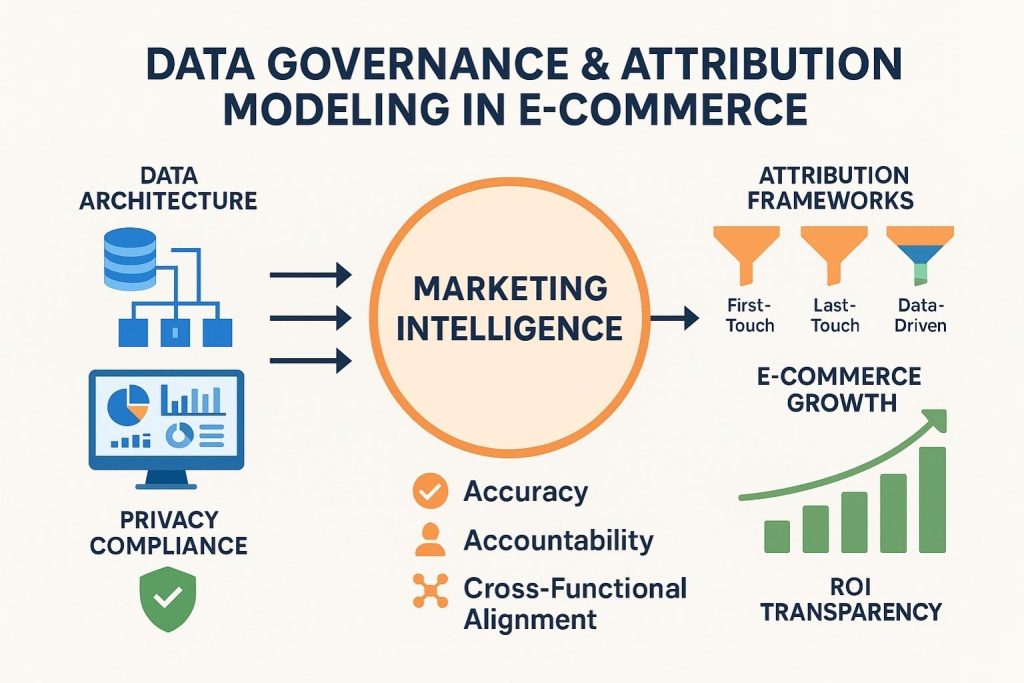
The Foundation of Marketing Intelligence
No e-commerce brand can scale sustainably without strong data discipline. Poor data quality or fragmented reporting leads to wasted ad spend, inaccurate forecasting, and misleading insights. A fractional CMO for eCommerce builds governance systems that make every marketing dollar traceable and every performance metric accountable.
Data governance isn’t only about accuracy; it’s about alignment and accessibility. All teams, from paid media to retention, must work from a unified data source with shared definitions for KPIs such as CAC, LTV, and churn. Without this consistency, attribution modeling and decision-making degrade quickly.
According to MarketResearch.com, the global e-commerce analytics market is projected to grow from US $10 billion in 2019 to US $32.8 billion by 2026, emphasizing how vital unified data architectures and governed attribution frameworks have become for modern e-commerce marketing operations.
Core Responsibilities in Data Governance
A fractional CMO ensures data integrity through a framework built around these pillars:
- Data Architecture: Designing systems that unify customer, transaction, and campaign data into centralized warehouses (e.g., BigQuery or Snowflake).
- Attribution Accuracy: Implementing multi-touch attribution (MTA) or data-driven attribution (DDA) models that properly credit conversions across channels.
- Measurement Consistency: Standardizing UTM tagging, event tracking, and goal hierarchies across all marketing platforms.
- Privacy Compliance: Ensuring GDPR and CCPA adherence through opt-in protocols and anonymized data collection.
By leveraging unified analytics frameworks, fractional CMOs convert raw data into actionable e-commerce insights, enabling leaders to make smarter, faster marketing decisions.
Attribution Modeling for Smarter Decisions
Attribution modeling is the art and science of crediting marketing touchpoints accurately. A seasoned ecommerce fractional CMO adapts attribution methods to the company’s maturity level and data infrastructure.
Common frameworks include:
- First-Touch Attribution: Ideal for early-stage growth, highlighting top-of-funnel discovery effectiveness.
- Last-Touch Attribution: Common but limited; overemphasizes final interactions.
- Data-Driven Attribution: AI-driven models assign credit proportionally across touchpoints.
- Incrementality Testing: Quantifies the lift of each channel beyond what would occur organically.
An optimized attribution framework transforms gut-based marketing into precision growth science. It empowers leadership to make confident budget reallocations, reduce acquisition costs, and scale only what works.
Why E-Commerce Needs Fractional CMO Leadership
Addressing the Unique Challenges of Digital Retail
E-commerce brands face marketing environments that shift weekly. Algorithms change, attribution windows shorten, and consumer preferences evolve rapidly. The modern marketing function must combine analytics, creative testing, and channel management into an integrated system.
A fractional director of e-commerce strategy provides the oversight necessary to manage this complexity. They ensure that every campaign, from paid acquisition to retention, operates within a data-driven framework. They also establish clarity between growth goals and operational capacity, aligning marketing outcomes with inventory, fulfillment, and customer experience.
Collaboration with Executive Leadership
While the fractional CMO defines the overarching strategy, the fractional e-commerce manager executes tactical programs. This partnership bridges the gap between planning and implementation. Together, they create synchronization across:
- E-commerce search engine optimization (SEO) initiatives.
- Performance media optimization, including paid social, PPC, and programmatic buying.
- Customer lifecycle management, from first touchpoint through repeat purchase.
This alignment produces measurable impact. Marketing ceases to be a set of campaigns and becomes an operational discipline driven by intelligence and accountability.
Strategic Oversight Across Functions
Fractional CMOs excel at integrating marketing with broader organizational functions. They work with finance to model ROI, with product teams to shape go-to-market plans, and with data analysts to interpret e-commerce insights for strategic decision-making. The result is a marketing operation that is both agile and financially transparent, capable of sustaining profitable growth in unpredictable markets.
Leveraging Generative AI for Strategic E-Commerce Growth
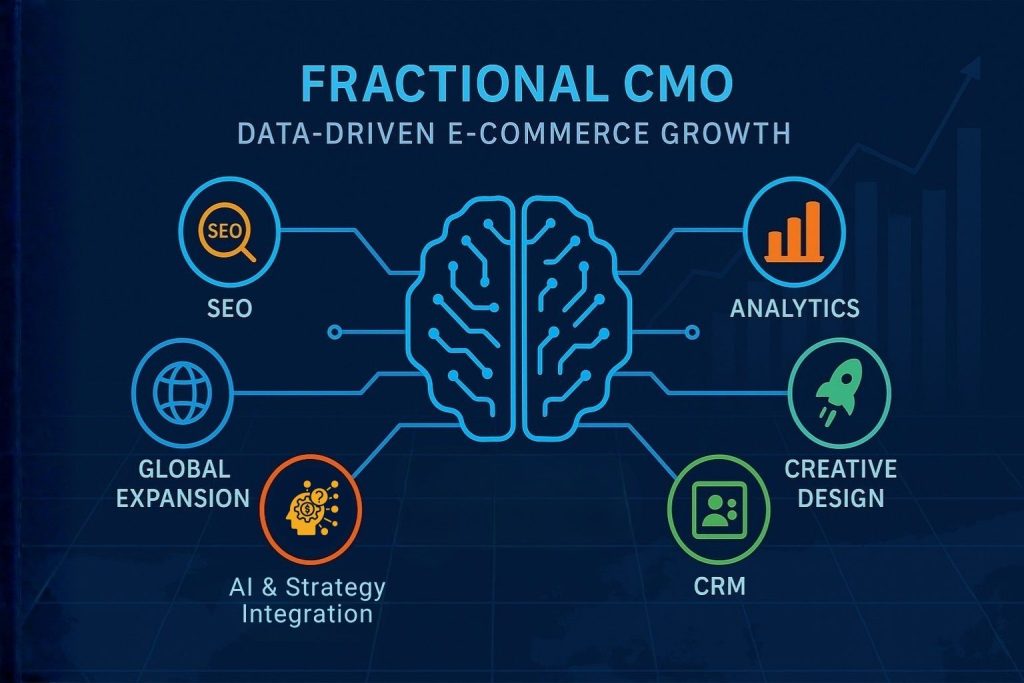
The Rise of Generative AI in Marketing
Generative AI e-commerce tools have redefined how brands create and optimize content automating ad copy, product descriptions, and audience targeting to deliver personalization at scale. Yet without strong leadership, AI adoption often becomes fragmented. According to the Stanford AI Index Report 2025, about 78% of organizations now use AI in at least one core business function, with marketing and e-commerce among the top areas of adoption.
A fractional CMO for eCommerce provides structure and accountability for AI integration. They ensure tools align with brand strategy, analytics, and customer experience goals. Rather than replacing creativity, AI enhances it under guided governance. Fractional CMOs set clear standards for content, journey design, and predictive analytics, ensuring innovation drives measurable business impact.
Operational Applications of Generative AI
Fractional CMOs leverage generative AI to streamline several marketing processes:
- Creative automation for ad copy, product visuals, and promotional campaigns.
- Predictive demand modeling to optimize media allocation and inventory alignment.
- Personalized content strategies that dynamically adapt to customer behavior.
- Enhanced data storytelling through automated insight generation and visualization.
These capabilities enable e-commerce organizations to operate with greater speed and precision, increasing revenue while controlling costs.
The Role of Human Oversight
While AI provides scalability, human oversight ensures context and brand integrity. A fractional CMO develops governance frameworks for AI use, ensuring compliance, brand consistency, and measurable impact. They balance automation with human judgment to maintain authenticity in every customer interaction. This blend of intelligence and creativity defines the next evolution of strategic marketing leadership.
Building an Integrated E-Commerce Ecosystem
The Role of Strategic Coordination
A fractional CMO for eCommerce acts as the architect of a company’s entire marketing ecosystem. Their role extends beyond campaign planning into structural integration across data, technology, and creative functions.
They align e-commerce marketing agencies, in-house teams, and third-party tools under a unified strategy. According to the U.S. Census Bureau’s Q2 2025 E-Commerce Sales Report, U.S. online retail sales reached $304.2 billion, up 5.3 % year over year, maintaining roughly 5–6% annual growth heading into 2026.
Sustaining performance at this scale demands coordinated leadership that connects every marketing function to commercial results. This ensures that every partner works toward shared objectives such as conversion efficiency, margin optimization, and customer retention.
Unifying Marketing, Product, and Technology
Fractional CMOs design workflows that merge creative execution with data-driven optimization. They coordinate teams handling:
- SEO and content operations that enhance organic visibility.
- Paid acquisition through multi-channel strategies.
- CRM and retention programs powered by automated triggers and dynamic segmentation.
- Analytics and insight reporting to measure attribution and lifetime value.
This orchestration transforms disconnected marketing functions into an interdependent growth engine.
Optimizing Agency Collaboration
Partnership with external e-commerce marketing agencies remains critical. However, without CMO-level direction, agencies often operate in isolation. The fractional CMO ensures these partnerships remain strategic. They establish governance systems, define key performance indicators, and align creative deliverables with conversion targets.
Similarly, a fractional CMO for consumer services helps service-based e-commerce brands refine customer experience strategies and ensure retention-focused marketing execution. A fractional CMO for consumer products or a fractional CMO for consumer services integrates product marketing with brand experience, ensuring every agency output reinforces the company’s market position.
Through this alignment, marketing operations evolve from siloed functions to a cohesive commercial ecosystem.
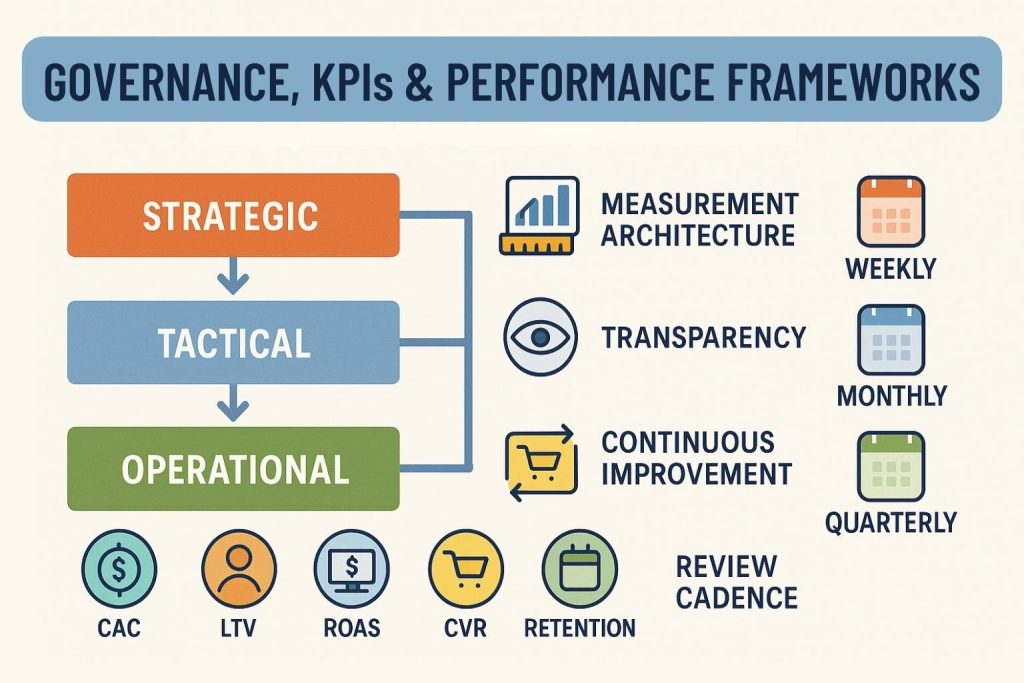
Governance, KPIs, and Performance Frameworks
Operationalizing Accountability in Marketing
Even the most advanced e-commerce strategies fail without a disciplined system for performance measurement. A fractional CMO for ecommerce doesn’t simply craft a strategy; they operationalize it into measurable frameworks with clear ownership. This accountability transforms marketing from a cost center into a profit engine.
Building the Measurement Architecture
Fractional CMOs typically implement three layers of governance:
- Strategic Layer: Defining business-level KPIs that align with financial outcomes, revenue, contribution margin, and retention rates.
- Tactical Layer: Monitoring channel-specific metrics such as ROAS, CPC, CPM, and engagement rates.
- Operational Layer: Tracking execution quality, workflow efficiency, and campaign velocity.
This structure ensures that every marketing initiative has a quantifiable business link, reducing wasted effort and improving transparency between marketing and executive teams.
Common KPI Frameworks Used by Fractional CMOs
A well-designed performance dashboard typically includes:
- Customer Acquisition Cost (CAC): Monitors the spending efficiency by channel.
- Lifetime Value (LTV): Evaluates the long-term profitability of customer cohorts.
- LTV:CAC Ratio: A critical measure of sustainable growth.
- Conversion Rate (CVR) and AOV: Key indicators for e-commerce funnel health.
- Churn and Retention Rates: Essential for subscription or repeat-purchase models.
- ROAS: A tactical efficiency measure for paid campaigns.
Institutionalizing Review Cadence
High-performing fractional CMOs implement a review cadence to maintain momentum:
- Weekly: Channel and agency performance stand-ups.
- Monthly: Strategic review of campaign data and spend allocation.
- Quarterly: Executive-level business impact review.
By embedding these rhythms, brands can pivot quickly based on real-time data while maintaining long-term strategic focus. The outcome is a culture of accountability and precision, hallmarks of mature marketing operations.
Leadership Transition and Knowledge Transfer Framework
Designing Sustainable Marketing Leadership
A major differentiator between an ordinary engagement and a transformational one lies in how the fractional CMO departs. The best fractional CMOs build systems that outlast their tenure, ensuring the company’s marketing performance doesn’t collapse once they exit. This process is structured around leadership continuity, documentation, and capability development.
E-commerce companies often experience leadership gaps when executives rotate or when projects conclude. A fractional e-commerce manager complements the CMO during these transitions, maintaining execution momentum while the team adapts to new leadership rhythms.
Structured Knowledge Transfer Process
A mature fractional CMO builds transferability into every phase of engagement:
- Process Documentation: Creating detailed marketing playbooks outlining workflows, analytics methodologies, creative standards, and testing frameworks.
- Capability Development: Conducting internal training sessions for managers and specialists on campaign strategy, performance analysis, and attribution.
- Governance Transition: Establishing clear success metrics and ownership models so that leadership changes don’t disrupt execution cadence.
- Technology Ownership: Ensuring login credentials, dashboards, and data repositories are centrally documented and accessible to authorized teams.
Operational Maturity as a Legacy
Fractional CMO engagements succeed when they leave behind operational maturity, the ability for a marketing function to operate on its own while still aligned to long-term business objectives. The CMO becomes not just a strategist but a builder of systems, equipping internal teams to sustain results without constant executive intervention.
The true value, therefore, lies not in the hours billed but in the intellectual capital transferred to the organization.
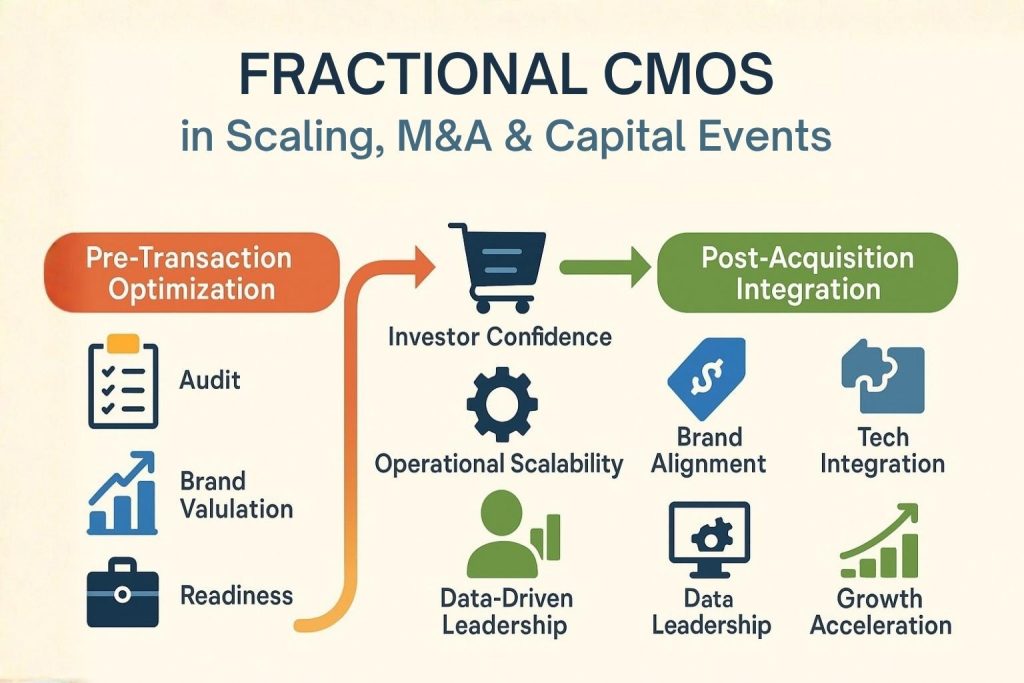
Fractional CMOs in Scaling, M&A, and Capital Events
Marketing Leadership in High-Stakes Growth Scenarios
When e-commerce companies reach pivotal moments scaling internationally, preparing for acquisition, or raising capital, marketing leadership becomes mission-critical. A fractional CMO for ecommerce bridges the gap between short-term execution and long-term investor readiness.
For startups transitioning from founder-led marketing to structured growth, or for mid-market brands seeking professionalization before a funding round, fractional CMOs provide both strategy and credibility.
Pre-Transaction Marketing Optimization
Before an M&A or funding event, fractional CMOs typically focus on:
- Marketing Audit: Assessing customer acquisition cost (CAC), retention rates, and marketing ROI to identify optimization opportunities.
- Brand Valuation Enhancement: Strengthening brand equity through refined messaging and performance consistency.
- Operational Readiness: Standardizing reporting dashboards and financial visibility for due diligence.
This preparation ensures that investors or acquirers perceive the marketing function as a scalable, data-driven growth engine, not a risk.
Post-Acquisition Integration and Growth Acceleration
After an acquisition or capital infusion, the CMO’s role shifts to unifying culture, systems, and strategy:
- Brand Consolidation: Aligning multiple entities under a shared identity and messaging framework.
- Technology Integration: Merging CRM, analytics, and marketing automation systems to eliminate redundancy.
- Growth Framework Activation: Reallocating capital toward high-ROI initiatives validated through performance data.
Strategic Advantage for Investors
Private equity firms and venture investors increasingly engage fractional CMO services during transitional phases because they deliver measurable traction without the long-term cost of a C-level hire. This alignment of flexibility, experience, and execution speed makes fractional CMOs uniquely valuable in high-stakes corporate milestones.
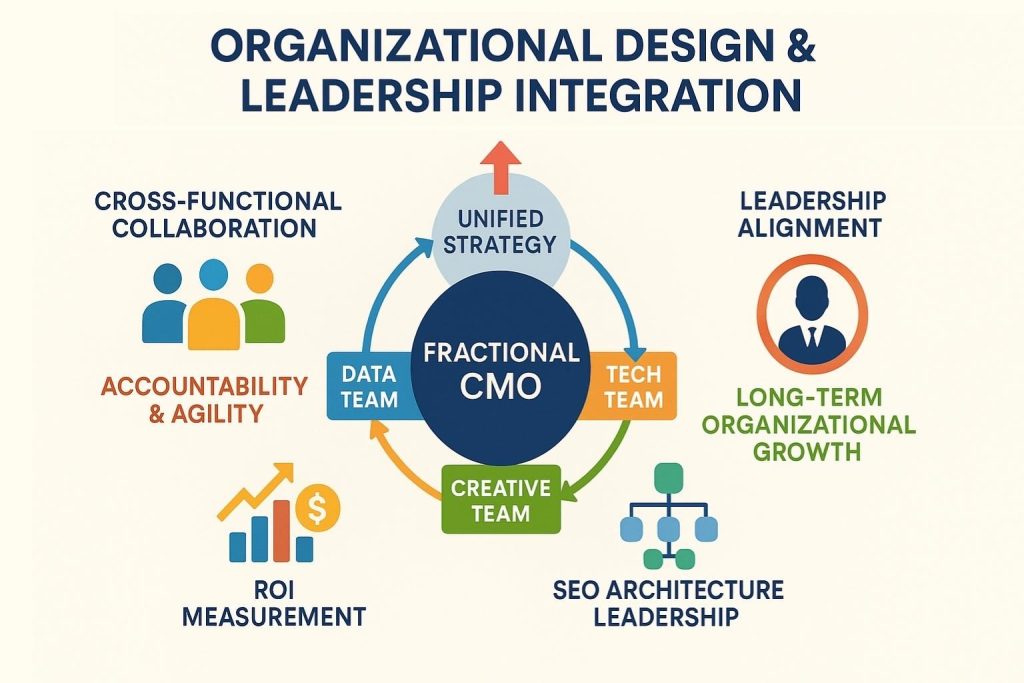
Organizational Design and Leadership Integration
Integrating Fractional CMOs into E-Commerce Structures
A fractional CMO serves as the architect of a company’s marketing ecosystem, connecting data, technology, and creative functions under one unified vision. They typically report to the CEO or board and collaborate across product, sales, and operations to ensure that marketing strategy aligns with commercial outcomes. Rather than focusing solely on campaigns, fractional CMOs drive structural integration, establishing clear roles, workflows, and shared performance metrics across teams and partners.
To create accountability and agility, they implement reporting systems based on OKRs and KPIs that track impact across every initiative. This approach transforms marketing from a cost center into a measurable growth engine. Decisions become data-driven, not opinion-driven, and performance tracking enables faster pivots when market conditions change. By embedding analytics into daily operations, fractional CMOs ensure teams remain aligned, efficient, and outcome-oriented.
According to eMarketer (2025), CMOs at top U.S. advertisers now average about 3.1 years in tenure, the shortest on record. This leadership volatility has fueled the rise of fractional CMO services, which deliver continuity, senior-level expertise, and institutional knowledge without long-term overhead. As organizations scale and evolve, fractional CMOs provide the consistent strategic direction needed to connect marketing performance directly to revenue growth.
Collaboration Across Leadership Layers
Effective integration also involves aligning the fractional CMO with internal stakeholders, such as:
- Marketing directors are responsible for campaign execution.
- Data analysts who interpret insights and manage attribution.
- Finance teams that assess ROI and budget allocation.
- Product managers who align go-to-market strategies with promotional planning.
This cross-functional collaboration enhances communication and prevents duplication of effort. It creates an environment where insights flow freely across departments and where every marketing decision supports the company’s financial model.
Partnering with Creative Agencies
Creative agencies play an essential role in executing large-scale initiatives. The fractional CMO sets the strategic direction while the agency brings creative innovation and production capacity. This hybrid model maximizes agility. Strategy remains internal and adaptable, while execution remains specialized and efficient.
Such partnerships ensure that campaigns maintain both strategic integrity and creative excellence, reinforcing the brand’s position in competitive markets.
The ROI of Fractional Marketing Leadership
Measuring Impact and Value Creation
The most compelling reason to engage a fractional CMO for eCommerce lies in measurable performance gains. These executives are results-oriented leaders who implement rigorous analytics and reporting frameworks. They define key metrics that directly connect marketing performance to financial outcomes, including:
- Customer acquisition cost (CAC)
- Customer lifetime value (LTV)
- Marketing efficiency ratio (MER)
- Revenue contribution by channel
By translating marketing outcomes into financial metrics, fractional CMOs bring transparency to budget allocation and help organizations prioritize high-return initiatives.
Comparative ROI vs. Traditional Leadership
Hiring a full-time CMO represents a long-term financial commitment, often with delayed impact due to onboarding and organizational alignment. In contrast, ecommerce fractional CMOs deliver immediate value by leveraging prior experience and established frameworks. Their impact compounds over time through consistent optimization and team development.
In comparison with e-commerce marketing agencies, fractional CMOs ensure every dollar spent aligns with strategic goals. Agencies provide execution, but fractional CMOs ensure that execution produces measurable profit.
Long-Term Organizational Benefits
Fractional CMOs also create enduring organizational value. They leave behind frameworks, systems, and processes that continue generating ROI long after their engagement concludes. This includes standardized reporting templates, data pipelines, and performance dashboards that embed marketing accountability across the company.
Their role in developing leadership capacity and decision discipline ensures sustainable growth, not just short-term results.
E-Commerce SEO and Content Architecture Leadership
SEO as an Executive Discipline
In modern e-commerce, SEO is not merely a technical or content function; it is a structural pillar of the digital business model. Visibility in organic search directly influences acquisition cost, conversion rates, and long-term brand equity. A fractional CMO for ecommerce ensures that the SEO strategy aligns with commercial objectives rather than being treated as an isolated marketing channel.
Fractional CMOs collaborate with developers, UX designers, and content teams to build a unified approach to organic discovery. This leadership ensures that every page, from product listings to educational content, contributes to measurable business value.
Core Responsibilities of the Fractional CMO in SEO Leadership
- Information Architecture: Designing category and product taxonomies that improve crawlability, internal linking, and user experience.
- Technical Optimization: Overseeing schema markup, page speed performance, and structured data implementation for search visibility.
- Content Ecosystem Management: Balancing conversion-focused copy with keyword depth, integrating long-tail search intent, and aligning product storytelling with user demand.
- Cross-Functional Coordination: Ensuring SEO efforts complement paid acquisition, influencer programs, and PR initiatives.
By uniting technical precision with creative strategy, the fractional director of e-commerce strategy builds an SEO foundation that scales across markets and devices.
From Visibility to Revenue Attribution
Advanced fractional CMOs also integrate e-commerce search engine optimization with attribution modeling. They evaluate how organic traffic contributes to multi-channel conversions, using data-driven insights to refine both content and ad spend.
SEO becomes not just a top-of-funnel awareness tool but a sustainable profit driver. Over time, this approach reduces dependency on paid media and strengthens overall marketing resilience.
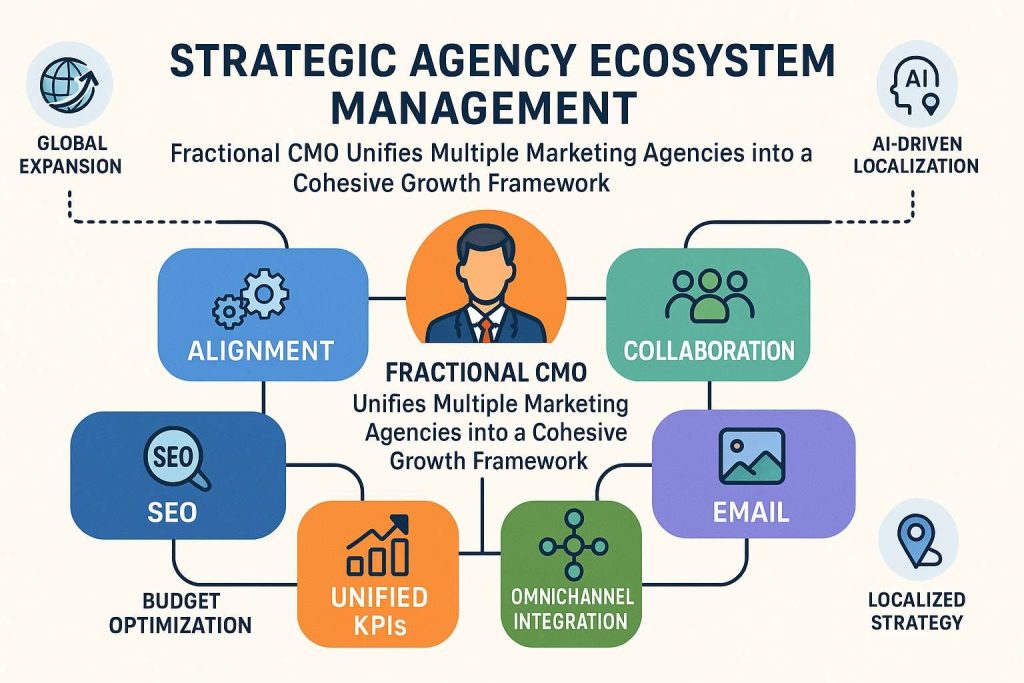
Strategic Agency Ecosystem Management
Rethinking the Agency Relationship
Many e-commerce brands rely on several specialized agencies for SEO, paid media, creative, and email marketing. While these teams may perform well individually, a lack of centralized oversight often leads to misaligned strategies, duplicate reporting, and inefficient spending. According to Shopify’s Global E-Commerce Sales Growth Report (2025), e-commerce will account for approximately 21.1% of global retail sales by 2026, highlighting how digital commerce has become the core of retail transformation rather than a secondary channel.
A fractional CMO for eCommerce serves as the strategic conductor across agencies, aligning all partners under a unified performance framework. This ensures consistent messaging, optimal resource allocation, and measurable ROI across every marketing initiative.
Creating a Unified Operational Framework
Fractional CMOs establish processes that convert fragmented agency relationships into cohesive partnerships:
- Unified Goal Setting: Defining common KPIs that connect creative performance with revenue outcomes.
- Cross-Agency Collaboration: Facilitating monthly or quarterly performance reviews to align creative and analytical priorities.
- Budget Allocation: Redistributing investment across agencies based on marginal ROI rather than fixed retainers.
- Contractual Accountability: Implementing transparent scopes of work, shared dashboards, and performance-based compensation where applicable.
Agency Partnership as Strategic Extension
When properly managed, agencies act as a natural extension of the brand’s internal team. Under fractional leadership, they move from task execution to strategic contribution, proposing innovations grounded in data, rather than reacting to disconnected briefs.
This system not only enhances creative output but also improves operational efficiency, as duplication and misaligned incentives are minimized. The fractional CMO services model thus elevates agencies from vendors to collaborators within a unified growth architecture.
Global and Omnichannel Expansion Strategy
Scaling E-Commerce Beyond Borders
For many brands, growth means expansion into new markets and channels. Managing this process requires sophisticated coordination across technology, localization, logistics, and marketing strategy. A fractional CMO for ecommerce plays a central role in transforming a brand’s growth ambition into operational reality.
International expansion is not simply about translation or logistics. It involves understanding local consumer behavior, payment preferences, cultural norms, and competitive dynamics. Fractional CMOs design adaptable marketing frameworks that maintain brand integrity while aligning with regional nuances.
Omnichannel Integration and Market Entry
Fractional CMOs connect digital and physical commerce through structured planning and seamless cross-channel integration. Their leadership ensures consistent messaging, offers, and customer experiences across websites, marketplaces, retail partnerships, and social platforms. According to eMarketer, U.S. retail social commerce sales are forecast to surpass US $100 billion by 2026, reflecting the accelerating convergence of content, community, and commerce. In parallel, mobile commerce continues to dominate online retail, representing nearly 59% of global e-commerce transactions.
This evolution underscores why omnichannel leadership is now mission-critical, ensuring every digital and physical touchpoint operates as part of a unified, data-driven growth strategy.
Key Focus Areas:
- Localized Creative Strategy: Tailoring visuals, tone, and promotions for regional audiences.
- Performance Infrastructure: Using unified analytics to manage global channel optimization.
- Channel Synergy: Aligning DTC, wholesale, and retail to eliminate internal competition.
- Generative AI for Localization: Employing generative AI e-commerce tools for multilingual, culturally adaptive content.
These trends highlight why omnichannel orchestration, led by fractional CMO services, is essential for achieving scalable, globally consistent growth
Sustaining Global Growth
Scalable success in global e-commerce depends on balancing efficiency with adaptability. The fractional director of e-commerce strategy maintains governance through standardized reporting, centralized martech systems, and region-specific KPI dashboards. This allows headquarters to maintain visibility while empowering local execution.
The result is a unified, omnichannel growth framework capable of driving profitable expansion across geographies and customer segments.
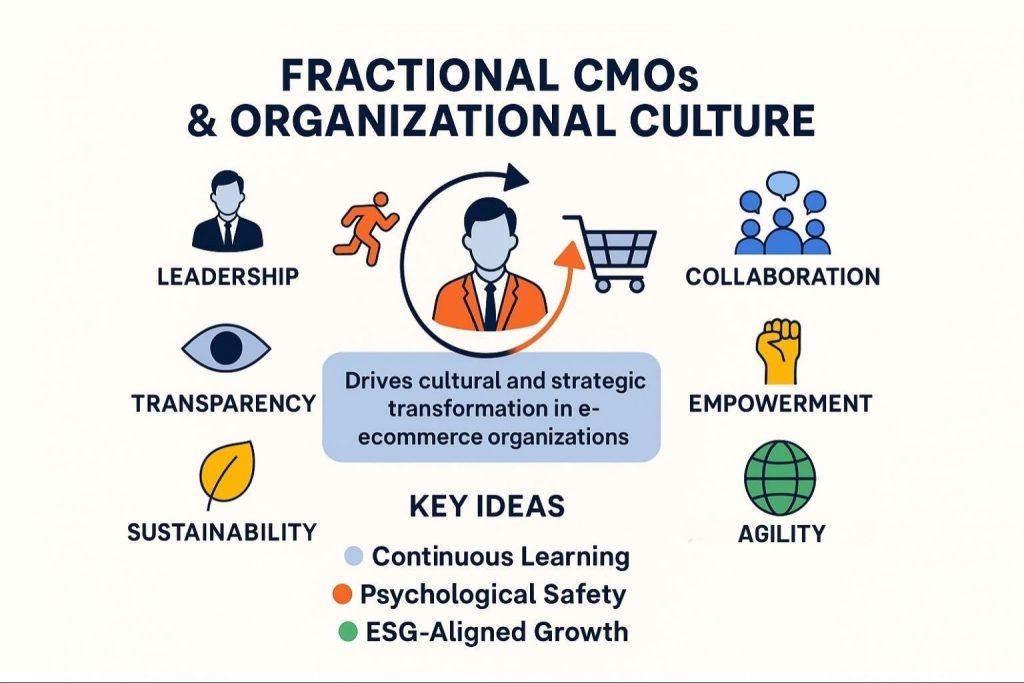
Fractional CMOs and Organizational Culture
Leadership Beyond Strategy
A high-performing marketing strategy requires more than frameworks and dashboards. It demands a strong organizational culture that supports innovation, cross-departmental collaboration, and accountability. A fractional CMO for ecommerce acts as a cultural architect, shaping the mindset of marketing teams to think strategically, experiment confidently, and execute efficiently.
Fractional CMOs bring fresh perspectives from multiple industries, helping teams challenge outdated assumptions and adopt best practices. This cultural influence extends well beyond marketing, often touching product development, operations, and customer experience.
Building a Culture of Agility and Ownership
Sustained success in e-commerce requires teams that are not only data-driven but also adaptable and proactive. Fractional CMOs foster this through:
- Transparency: Implementing open reporting systems that make performance metrics visible to all stakeholders.
- Empowerment: Encouraging cross-functional collaboration where designers, analysts, and strategists jointly own campaign outcomes.
- Continuous Learning: Promoting experimentation, A/B testing, and post-mortem analysis as normal parts of the workflow.
- Psychological Safety: Creating an environment where teams can test new ideas without fear of blame, allowing creativity to flourish.
Cultural Legacy of Fractional Leadership
When executed well, a fractional CMO engagement leaves behind a team that is more confident, data-literate, and self-sustaining. The leader’s influence persists long after the engagement ends because the systems, behaviors, and principles they instill become part of the company’s DNA.
This human element completes the strategic equation. By combining technical expertise with cultural development, fractional CMOs help brands achieve not just faster growth but more resilient, adaptable organizations capable of thriving in constantly evolving markets.
The Competitive Advantage of Responsible Leadership
Sustainability-focused marketing is now a differentiator in crowded markets. Forward-looking brands are also adopting fractional CMO services for sustainability, ensuring that their marketing strategies align with environmental, social, and governance (ESG) objectives without sacrificing performance.
A fractional CMO for consumer products or a fractional director of e-commerce strategy can reposition a brand to capture emerging eco-conscious audiences without compromising profit targets.
By uniting long-term environmental vision with near-term commercial outcomes, fractional CMOs build brands that scale responsibly. The outcome is measurable lower customer churn, improved brand trust, and stronger investor confidence in ESG-aligned operations.
Sustainable growth is no longer optional in modern commerce; it is a strategic imperative. Fractional CMO services for sustainability enable e-commerce brands to operationalize that imperative with precision, transparency, and measurable return.
Final Thoughts
The fractional CMO for eCommerce represents a new model of marketing leadership designed for a world of rapid change and intense competition. By combining strategic vision, operational precision, and cross-functional collaboration, fractional CMOs empower e-commerce brands to scale efficiently and intelligently. They bring order to complexity, transforming marketing from a reactive cost center into a proactive growth engine.
Creative partners complement this structure by delivering the expertise needed to bring strategy to life. Together, fractional CMOs and creative agencies create a dual framework for growth: strategy anchored in business logic, and creativity rooted in insight.
In an environment where agility defines success, adopting fractional CMO services allows organizations to access world-class leadership, reduce operational risk, and maintain momentum in every market cycle. This model is not merely a cost-saving measure; it is a strategic evolution that defines the future of competitive advantage in e-commerce.
Top FAQs: Fractional CMO for eCommerce
Q1: When should an eCommerce brand hire a fractional CMO for eCommerce?
A: When sales growth stalls, ad spend becomes inefficient, or leadership lacks strategic marketing direction before scaling or fundraising.
Q2: How long does a fractional CMO engagement typically last for eCommerce companies?
A: Most last 6–12 months, covering audit, strategy development, implementation, and internal team enablement for long-term sustainability.
Q3: What results can a fractional CMO deliver in the first 90 days?
A: Expect faster CAC reduction, clearer KPI alignment, and reallocation of ad budgets toward high-ROAS channels through rapid audits and optimization.
Q4: How does a fractional CMO for eCommerce work alongside existing agencies or in-house teams?
A: They provide executive-level coordination aligning creative, paid media, and analytics teams under a unified performance strategy and KPI framework.
Q5: How is success measured after hiring a fractional CMO for eCommerce?
A: Success is tracked through metrics like LTV:CAC ratio improvement, revenue growth, retention lift, and the creation of scalable marketing systems.
Q6: What makes a fractional CMO different from a marketing agency or consultant?
A: Unlike agencies or consultants, a fractional CMO takes ownership of outcomes, integrating into leadership, managing execution, and tying strategy directly to profit.

Transforming E-Commerce Marketing Leadership with RiseOpp’s Fractional CMO Approach
At RiseOpp, we’ve built our company around the same principles that define exceptional fractional marketing leadership: clarity, precision, and measurable growth. We partner with e-commerce brands that want more than surface-level marketing support; they want leadership that unites strategy, data, and creativity into one cohesive engine of performance.
As a leading provider of Fractional CMO and SEO services, we help both B2B and B2C companies establish strong brand positioning, scalable marketing systems, and integrated growth frameworks. Our proprietary Heavy SEO methodology enables clients to rank for tens of thousands of keywords over time, while our fractional CMO engagements bring executive-level strategy to every channel from Google Ads and Meta Ads to TikTok, LinkedIn, PR, and affiliate marketing.
In the evolving world of generative AI and data-driven e-commerce, we believe effective marketing leadership is not just about managing campaigns, it’s about building adaptable systems that sustain growth. That’s why we work as an embedded strategic partner, not an external vendor, ensuring every decision aligns with long-term business goals.
If your organization is ready to elevate its marketing performance and lead with strategy, not reaction, let’s transform your marketing into a scalable growth engine that thrives in the age of AI.
Comments are closed